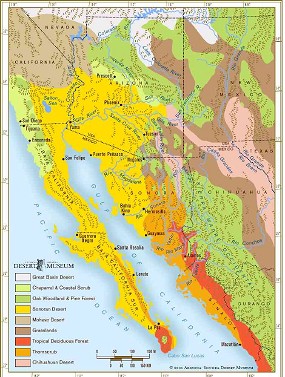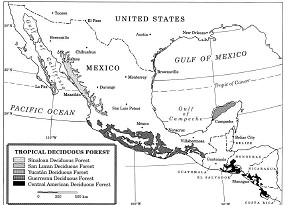Research and Conservation in Southern Sonora, Mexico
(Centered in Alamos)
Tropical Deciduous Forest and the Sonoran Desert:
A Strong Connection
The Arizona-Sonora Desert Museum has an enduring interest in the Tropical Deciduous Forest (aka Tropical Dry Forest or simply TDF) of southern Sonora.
Here we present the natural history of tropical southern Sonora to promote and facilitate research and conservation activities in that region. The section on research opportunities and the plant names database are specifically addressed to that end. Many of the species accounts are sketchy; they are intended mainly to serve as pictorial supplements to existing scientific literature on the region.
Introduction
TDF can be called the grandmother of the Sonoran Desert. (Thornscrub is its mother.)
The modern climatic and biotic regimes of North America were established by the uplifts of the Sierra Madre Occidental and Rocky Mountains in the Oligocene and Miocene. The uplift of the Sierra Madre restricted tropical vegetation to lowland bands along the coasts of the continent. Northwest of the Sierra Madre, tropical vegetation was isolated in the modern Sonoran Desert Region from Sinaloa to California. The nearest relatives of important Sonoran Desert plants including the cardon or sahueso (Pachycereus pringlei), cochal (Myrtillocactus cochal), saguaro (Carnegiea gigantea), and senita (P. schottii) are far to the southeast in south-central Mexico.
Most of the adaptations to bright sunlight, heat and aridity that allow plants to live in deserts, evolved in the dry season in tropical deciduous forests long before the deserts of North America existed. As the climate of North America gradually dried out during the middle Miocene, numerous plant and animal species of the dry tropics that were preadapted to desert climate extremes thrived or evolved into new species as the Sonoran Desert formed by about eight million years ago. Today about half of the plants and a similar number of the animals of the Sonoran Desert are derived from tropical ancestors. Wetter portions of the Sonoran Desert resemble a very dry tropical forest with the phenology of its tropical components driven by the brief, weak summer monsoon that averages only two and a half months and brings about 6 inches (150 mm) of rain. (Compare this with the 30 inches (760 mm) of rain in southern Sonoran TDF.)
Understanding the tropical dry forest and thornscrub of Sonora facilitates comprehending the ecology of the Sonoran Desert. The Desert Museum has been actively involved in research in southern Sonora's tropics since the 1960s. A great deal of work has been done in eastern Sonora, in the Municipio of Yecora. Our current focus and subject of this website is in the vicinity of Alamos in southern Sonora.
|
Tropical deciduous forest in the New World occurs in a nearly continuous ribbon along the coast from southern Sonora south to Panama with an average width of only 50 km (Krizman 1972, Gentry 1995). There are also major areas of this community in South America, including some of the same plant and animal species that occur in Sonora. Throughout this area, dry tropical forests have been heavily impacted by human activities. Pre-Columbian and historic cultural impacts on tropical forests are very difficult to evaluate. To us the tropical deciduous forests of Sonora appear to have been impacted much less than those in more heavily populated areas to the south. The most extensive areas of mature tropical deciduous forests remaining today are likely in Sonora. The Desert Museum is working to preserve the best of what's left.
Southern Sonora is defined here as that part of the state located south of the latitude of Yécora (28 23'30"N). This includes all of the Tropical Deciduous Forest in the state. Most of the research reported here was conducted in the vicinity of Alamos in the extreme southeastern corner of Sonora, and along Mexcio Highway 16 from Hermosillo to Yécora.
The Desert Museum has conducted numerous research projects in eastern Sonora along a transect from Hermosillo to Yécora, including a large part of the Migratory Pollinators Program. Our current work is centered around the Spanish colonial town of Alamos near the southern tip of Sonora. Alamos offers numerous amenities to support biological research, environmental education, tropical conservation, and ecotourism.
Nomenclature: The species accounts do not include synonyms or authors unless there has been a recent change or disagreement on the name of a taxon. Refer to the plant names database for synonyms and authors of plants.

